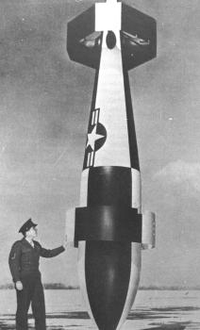Cornelius XBG-3
The Cornelius XBG-3 was an American "bomb glider", developed by the Cornelius Aircraft Corporation for the United States Army Air Forces. Using an unconventional design that included a forward-swept wing, a single prototype was ordered in 1942; however the contract was cancelled later that year before the aircraft had been constructed.
| XBG-3 | |
|---|---|
| Role | Bomb glider |
| Manufacturer | Cornelius Aircraft |
| Primary user | United States Army Air Forces |
| Number built | 0 |
| Type | Prototype |
| Serial | 42-46911[1] |
History
Early in the Second World War, the United States Army Air Forces initiated research into the possibility that gliders, towed by other, conventional aircraft to the area of a target, then released and guided to impact via radio control, could be a useful weapon of war.[2] Essentially an early form of (very large) guided missile,[2] the concept was similar to a Navy project underway at the same time, known as Glomb (from "glider-bomb"),[3] and led to the establishment of the 'BG' series of designations, for 'Bomb Glider', in early 1942.[2][3]
Among the designs considered for use as a bomb glider was an unconventional design submitted by the Cornelius Aircraft Company. Cornelius, having established a reputation for unconventional aircraft designs,[4] proposed a design that featured a "tail-first" configuration,[2] with canard foreplanes and a radical forward-swept wing.[3] The USAAF considered the design interesting enough to award a contract to Cornelius for the construction of a single prototype, designated XBG-3.[5] However the project was cancelled in late 1942, when the bomb glider concept was abandoned by the USAAF.[3][6]
An enlarged, tailess, forward-swept wing glider would be built by Cornelius later in the war, acting as a "flying fuel tank" for long-range bombers, as the XFG-1.[7]
See also
Related development
Aircraft of comparable role, configuration and era
- Fletcher BG-1
- Interstate TDR
- Mistel
- Pratt-Read LBE
Related lists
References
- Citations
- Baugher 2011
- Gunston 1988, p.28.
- Parsch 2009
- Miller 2001, p.297.
- Mondey 1978, p.132.
- Jane's 1947
- "Gliding Gas Tank May May Refuel Planes On Ocean Hops." Popular Science, August 1944, p. 124.
- Bibliography
| Wikimedia Commons has media related to Cornelius aircraft. |
- Baugher, Joe (January 6, 2011). "1942 USAAF Serial Numbers (42-39758 to 42-50026)". USAAS-USAAC-USAAF-USAF Aircraft Serial Numbers—1908 to Present.
- Bridgman, Leonard, ed. (1947). Jane's All The World'S Aircraft 1947. London: S.Low, Marston & Co. ASIN B000RMJ7FU.
- Gunston, Bill (1988). The Illustrated Encyclopedia of Aircraft Armament. London: Salamander Books. ISBN 978-0-86101-314-2.
- Miller, Jay (2001). The X-Planes: X-1 to X-45. Hinckley, England: Midland Publishing. ISBN 978-1-85780-109-5.
- Mondey, David (1978). The Complete Illustrated Encyclopedia of the World's Aircraft. New York: A&W Publishers. ASIN B001SLTA1U.
- Parsch, Andreas (2008). "BG Series". Directory of U.S. Military Rockets and Missiles, Appendix 1: Early Missiles and Drones. designation-systems.net.
